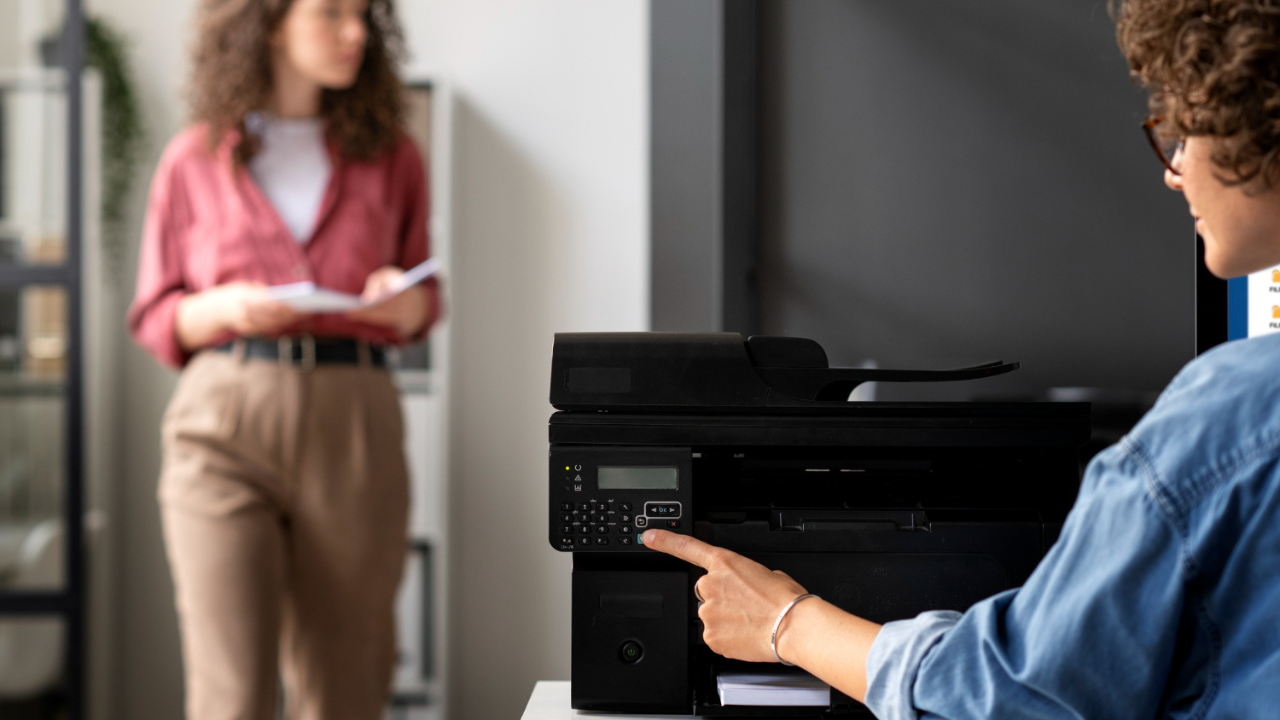
Small teams often share one device, so the wrong choice can quickly become a daily frustration.
If you are buying a laser printer there are a few factors that you need to consider, such as color vs monochrome, print volume, single-function vs multifunction, connectivity, speed, paper capacity, and the total cost of ownership.
How To Choose The Best Laser Printer? Laser Printer Buying Guide

With the right laser printer buying guide, you can focus on what truly matters and avoid overspending on features you’ll never use.
1. Define Your Team’s Needs
Start by asking how many people will share your team’s laser printer. A team of three doesn’t print the same way as a team of twelve.
Estimate how many pages you’ll need each week. Decide if you’ll print mostly text or if high-quality graphics are essential. Think about the kind of documents you usually handle.
If your work is heavy on contracts and reports, a monochrome laser printer might be all you need. If your team prepares client-facing designs, color printing becomes necessary.
2. Check Print Speed And Efficiency
When a group shares a printer, speed can make or break workflow. Pages per minute (PPM) tells you how fast the machine pushes out documents.
A difference of just a few pages or images per minute adds up when deadlines loom. Faster models keep your team moving without long lines by the machine.
If you’re considering an office laser printer, look for models designed to balance speed with consistent quality, since small teams often need both efficiency and reliability in one device.
Some printers slow down with double-sided jobs or heavier paper. Others claim fast speeds but compromise excellent print quality at top settings. Balanced performance is key.
Also, review the recommended volume of sheets per month. This figure shows how much output the printer can handle consistently, which is especially important for shared devices that face daily use. Matching this number with your team’s workload helps extend the printer’s lifespan.
3. Look Into Print Quality
Resolution is often displayed in dots per inch (DPI). Higher DPI looks attractive, but you may not need it. For everyday text, 600 DPI is usually sharp enough.
Spending more on a printer delivering 1200 DPI may not add visible benefits unless your work involves fine graphics.
It’s important to see samples if possible. Some printers claim high resolution but struggle with consistent shading or gradients.
Instead of chasing numbers, focus on models known for excellent print quality, which means crisp text and clear images across different types of business documents.
This includes everything from proposals and invoices to legal-size pages, which often need the same sharpness as smaller formats.
4. Assess Connectivity Options
A small team benefits from multiple ways to connect. Standard USB may feel outdated, but it’s still useful for direct connections. Ethernet offers stability, especially if your team values consistent speeds over Wi-Fi convenience.
Wireless options are often the most practical. Wi-Fi Direct lets everyone print from laptops, tablets, or phones without moving files around.
Investing in a printer that supports mobile printing gives your team flexibility, especially when deadlines are tight and you need documents from anywhere in the office.
5. Consider Running Costs
The price tag doesn’t tell the whole story. Toner cartridges often cost as much as the printer itself after a few replacements.
Check the page yield, which shows how many prints you’ll get from one cartridge. Divide the cartridge cost by the yield to know your price per page.
Drums and maintenance kits may also need replacing. Some brands design printers with separate drums, while others build them into the cartridge. Separate drums usually mean lower toner prices, but occasional extra costs for the drum unit.
When comparing options, check how many sheets the printer can handle monthly without breaking down. A device rated for higher monthly use may come with toner that lasts longer and lowers long-term costs.
Always think long-term. A cheap laser printer with pricey toner can cost more than a premium model with affordable supplies.
6. Explore Reliability And Duty Cycle
The duty cycle measures how many pages a printer can handle per month without strain. You’ll see two numbers: recommended and maximum. Stick to the recommended range for best results. Using a printer beyond its limit shortens its lifespan.
Reliability isn’t only about numbers. Some machines are known for frequent jams or error codes. Reading user reviews helps you spot patterns in reliability before you commit.
Downtime feels much bigger for small teams because every member relies on the same machine.
If your team often produces lengthy reports or business documents that extend to legal-size pages, reliability becomes even more critical.
These tasks can push a printer to its limits, so choosing one with a higher sheets per month rating will save you from constant repairs.
7. Evaluate Size And Placement
Measure your space before buying. Printers that look compact in photos may take up half a desk. Check height and width to avoid surprises, especially in small offices.
Noise is another factor. A loud printer can be distracting when meetings or calls are happening nearby. Quiet models might be slightly more expensive but can improve comfort and focus.
Also, think about the paper you’ll use. Most laser printers are designed for standard plain paper, but if your team often switches to envelopes or card stock as marketing materials, you’ll want a model that adapts easily.
Some devices also handle plain paper alongside digital workflows, meaning you can print a draft from Google Drive as quickly as you’d print an internal memo.
8. Look At Extra Features That Add Value
Many laser printers now include scanning, copying, and faxing. For small teams, an all-in-one model saves space and avoids buying separate machines. It also streamlines workflows when digitizing or sharing files quickly.
Touchscreens make settings easier to manage. Instead of navigating confusing button menus, you tap options directly. Cloud integration is also valuable, allowing you to send documents from Google Drive or Dropbox without a computer.
Ease matters too. Devices with proven ease of setup save time right away. Instead of struggling with complicated manuals, your team can plug in, connect, and get started within minutes. That first impression sets the tone for years of use.
Top Benefits Of Laser Printers
It is undeniable that laser printers are meant to make life considerably easier. There are multiple benefits of using laser printers, such as,
- Laser printer speed is lightning fast
- The toner cartridges for laser printers are long-lasting and easy to maintain
- The print quality tends to be clean, sharp, and smudge-free
- Laser printing is efficient and economical
Why Choosing The Right Laser Printer Matters?
Choosing the right laser printer buying guide isn’t about chasing the latest or most expensive model. It’s about finding a reliable tool that keeps your team running smoothly day after day.
Whether you are prioritizing the photo quality, low running costs, or the print speed, there are different laser printer models that are best suited for you.
So, when you are choosing the best laser printer for either your personal or professional use, keep these factors in mind, along with the price, while making your decision.
Read Also:






